Doing homework with my six-year-old used to be a struggle every evening. Both of us dreaded it, and I’m pretty sure everyone else in the house did, too. But after a little brainstorming, I realized there was one big thing missing from our evening homework routine: physical activity.
It wasn’t reasonable for me to expect my daughter to come home and sit down to do homework after sitting all day at school and then sitting again for a long car ride home. So we’ve taken a more active approach that has made a world of difference. Here are my four steps to take homework time from hellish to happy.
Step 1: Create a Space
A big part of any practice requiring focus and attention- whether it’s exercise or homework – is preparing a space. Homework used to be done at the kitchen table. That works for some people, but in our family, the kitchen is a loud and busy place. My other two children would often try to “help” their older sister with her homework, which wasn’t helpful at all. Something had to change.
READ: Fight for the Right to Recess: 3 Reasons Kids Need Break Time
Now, homework time happens in a specific room and no one else is allowed to enter. While I’m waiting for my daughter to come home for school, I prepare the room. I clear off some floor space, grab a few beanbags, get pencils and other items ready, and diffuse pick-me-up oils like peppermint or rosemary. I prepare the room in the same way I would prepare a space to do yoga or write an article. I make it quiet, clean, and distraction-free.
“I prepare the room in the same way I would prepare a space to do yoga or write an article. I make it quiet, clean, and distraction-free.”
Clothing is another important aspect of creating space. If you have young children, you know how much their identity revolves around what they are wearing. After school, my daughter puts on her workout outfit to get ready to move before sitting down to tackle homework.
Step 2: Take Time to Breathe
Once the space is ready and the outfit is on, we sit down together and breathe. Breathing is a good way to help your child collect herself and transition into physical activity.
With kids, you don’t have to be fancy. You just want to do a brief breathing practice to help your child focus and center his or her attention. Here’s an example of how I would guide my daughter:
- Close your eyes and take a deep breath through your nose, all the way into your tummy.
- Open your mouth and release all the air. Repeat this two more times.
- Do the same thing, but on the inhale, raise your arms over your head. On the exhale, bring your arms down to your sides. Repeat this three more times.
- Now inhale deeply through your nose. Exhale softly through your nose. Repeat this three times.
- Now we are going to count our breathing. Inhale through your nose for three seconds, then breathe out through your nose for three seconds. (Count the breaths out for your child so he or she can focus on breathing deeply).
- Open your eyes. Smile.
You can use imagery during your breathing practice to help relieve any tension or anxiety your child might be feeling. It might take a little practice, but the benefits are astounding.
RELATED: Diaphragmatic Breathing Reduces Exercise Induced Oxidative Stress
Step Three: Get Moving
A 2014 study of over 200 students ages seven to nine found an after-school physical activity program increased the ability to focus, multitask, and retain information. Not only that, but the intervention also improved conditioning. The researchers concluded:
The current data not only provide causal evidence for the beneficial effects of physical activity (PA) on cognitive and brain health, but they warrant modification of contemporary educational policies and practices, and indicate that youth should receive more daily PA opportunities.
These interventions aren’t just for schools. Adding physical activity to the nightly homework routine has made a huge difference for my daughter. After the breathing practice, take fifteen to twenty minutes to do some kind of physical activity – go for a walk or jog, play tag, work out, or do yoga. If weather permits, get outside for this part. If not, do a bodyweight workout or a yoga sequence.
“A 2014 study of over 200 students ages seven to nine found an after-school physical activity program increased the ability to focus, multitask, and retain information.”
Here’s a simple sequence with kid-friendly stretches and yoga poses. As shown in the pictures, my daughter and I always face each other during this practice. This allows you to hold hands and maintain eye contact. This will keep your child engaged and make it more fun for both of you.
Seated Stretches
- Shoulder shrugs
- Neck stretch – side to side, roll from one shoulder to the other
- Easy seated twists
- Butterfly stretch
- Straddle stretch
Kneeling Stretches
- Dynamic movement from lunge to runner’s stretch (pictured below)
- Stay in modified crescent lunge with arms overhead for 10 seconds (pictured below)
- Frog squat – 10 seconds (pictured below)
Repeat this sequence three times
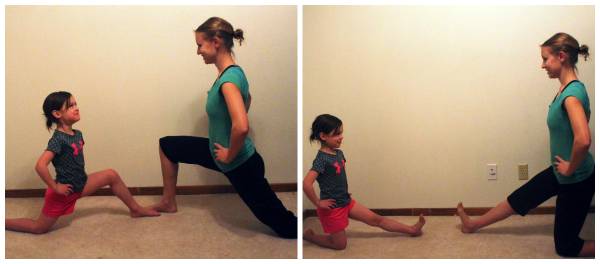
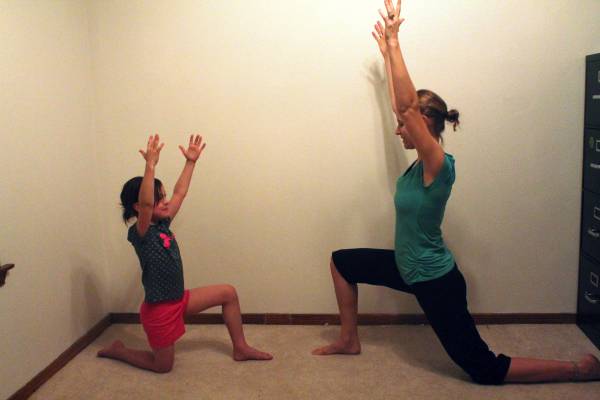
Lunge to runner’s stretch (top); modified crescent lunge (bottom)
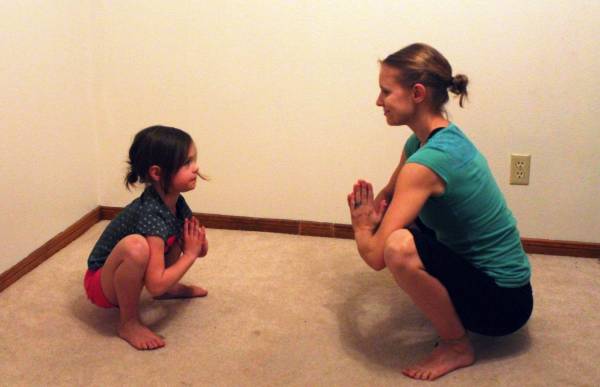
Frog Squat
Standing Poses
- Assisted half chair pose (pictured below)
- Forward fold – allow your child’s torso to rest on her thighs (pictured below)
- Assisted warrior I (pictured below)
Repeat this sequence three times
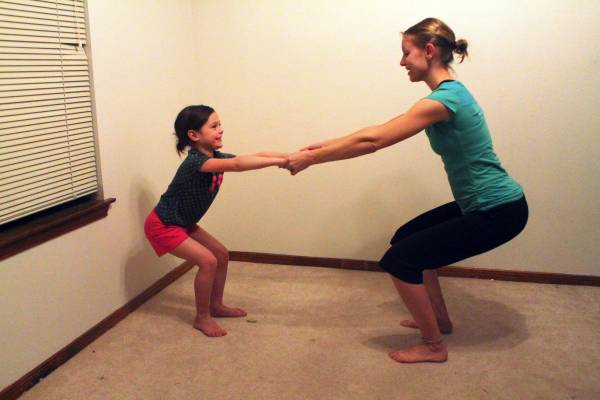
Assisted half chair pose
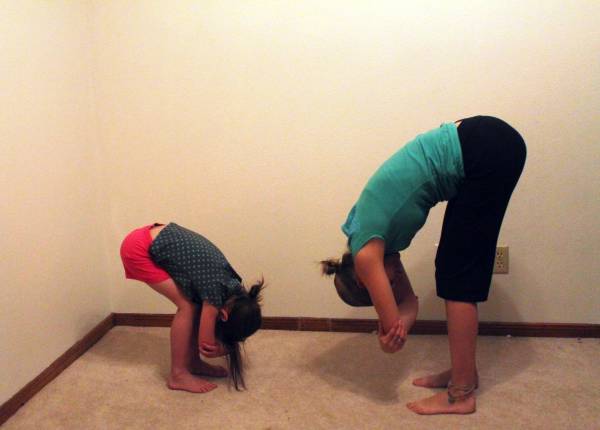
Forward fold
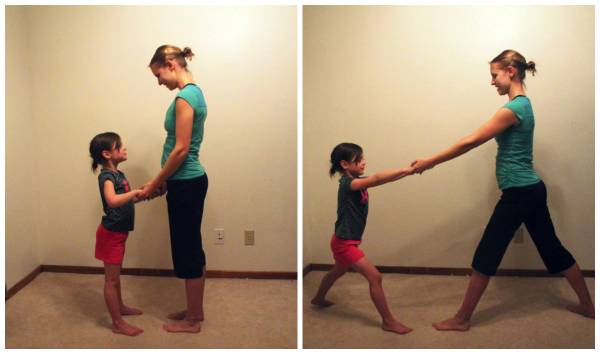
Getting into Warrior I by holding hands
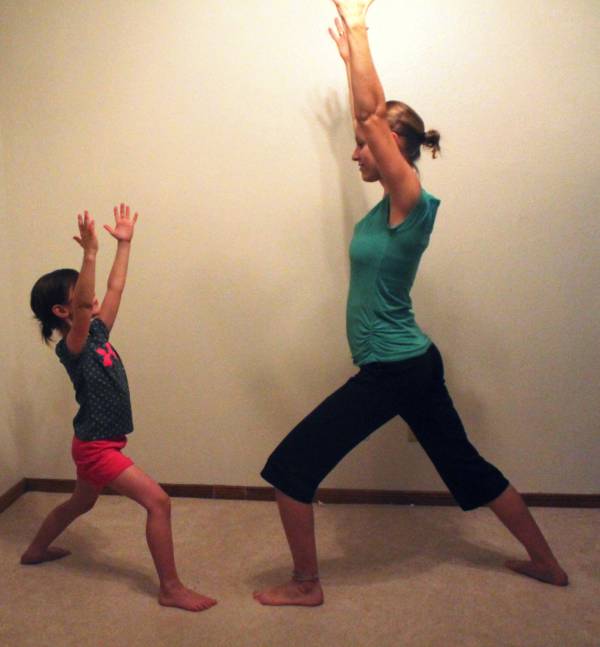
Warrior I
Step Four: Align the Spine
After your physical activity is over, it’s time to transition into homework mode. Creating space and alignment in the spine will help your child to sit back down and do homework with good posture. Add the following movements to the yoga sequence above or do them after any other activity.
- Leaning tower: Hold hands and stand up straight. Lean back as far as you can while keeping the spine straight, then come back together to stand up straight. This is a fun exercise that helps release tension. It also requires balance and coordination.
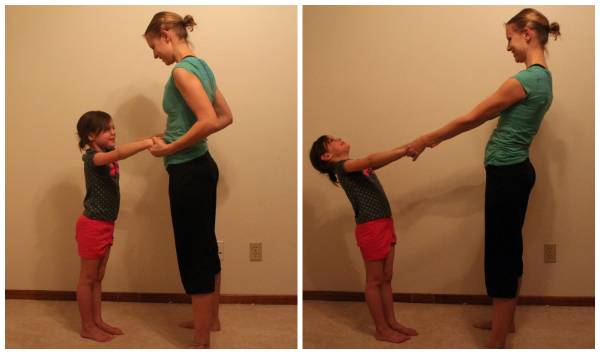
- Unlock your knees: My daughter is a chronic knee locker, just like her mom. Practice standing straight and tall while relaxing the knees.
- Hang like a puppet: Have your child fold all the way forward while you support her front ribs and low back, as pictured below. Then have her come up until her spine is extended, supporting her all the way up. Repeat this movement several times, cuing her to breathe deeply. This will help your child become more aware of what her spine feels like when it is rounded and extended.
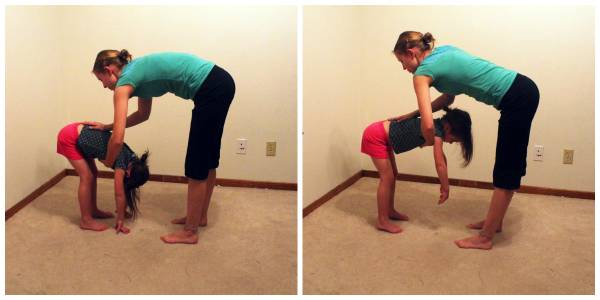
- Assisted half chair pose with spinal movement: Another way to help your child feel spinal alignment. Help your child experiment with rounding the spine and backbending while she is in a slight chair pose.

Left: Backbend; Center: Neutral spine; Right: Rounded spine
Now it’s time to go get a cup of peppermint tea, take out the backpack, and go over the homework for the evening. If you’re like me, you will take advantage of this quiet room and stay there. The benefits work both ways!
The day after we did this for the first time, my daughter came home excited to do her homework. Yes, I just used the words “excited” and “homework” in the same sentence. As with most things, the right combination of routine, fun, and movement have made an almost miraculous difference.
Do your kids struggle with homework? How have you made it more manageable for you and for them? Share in the comments below.
Photo 1 courtesy of Shutterstock.






